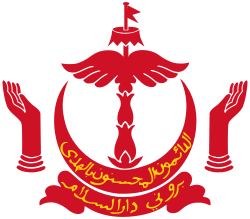Brunei–Malaysia relations
 | |
Brunei |
Malaysia |
|---|---|
| Diplomatic Mission | |
| Bruneian High Commission, Putrajaya | Malaysian High Commission, Bandar Seri Begawan |
| Envoy | |
| High Commissioner Alaihuddin Mohamad Taha |
High Commissioner Vacant Chargé d'affaires a.i. Rafedah Abd. Aziz |
Brunei–Malaysia relations (Malay: Hubungan Brunei–Malaysia; Jawi: هوبوڠن بروني–مليسيا) are foreign relations between Brunei and Malaysia. Brunei has a high commission in Kuala Lumpur, as well as consulate-generals in Kota Kinabalu and Kuching.[1][2] Malaysia maintains a high commission in Bandar Seri Begawan.[3] Both countries are full members of ASEAN and the Commonwealth of Nations. The two countries share a land border on the island of Borneo.
Country comparison
| Coat of Arms |  |
 |
| Flag |  |
 |
| Population | 417,200 | 31,360,000 |
| Area | 5,765 km2 (2,226 sq mi) | 330,803 km2 (127,724 sq mi) |
| Population Density | 72.11/km2 (186.8/sq mi) | 92/km2 (240/sq mi) |
| Time zones | 1 | 1 |
| Capital | Bandar Seri Begawan | Kuala Lumpur Putrajaya (administrative) |
| Largest City | Bandar Seri Begawan – 50,000 | Kuala Lumpur – 1,768,000 |
| Government | Unitary Islamic absolute monarchy | Federal parliamentary elective constitutional monarchy |
| Established | 17 September 1888 (Established as a protectorate by the British) 23 November 1971 (Self-government granted from the British Empire) 1 January 1984 (Independence from the British Empire proclaimed for Brunei) |
31 August 1957 (Independence from the British Empire proclaimed for the Federation of Malaya) 16 September 1963 (Proclamation of Malaysia) |
| Predecessor States | Medieval Kingdom Period (1368–1888) British Colonial Period (1888–1984) Japanese Occupation Period (1942–1945) Interim Military Period (1945–1946) Independent Period (1984–present) |
Portuguese Colonial Period (1511–1641) Dutch Colonial Period (1641–1825) British Colonial Period (1771–1946) Japanese Occupation Period (1942–1945) Interim Military Period (1945–1946) Self–Government Period (1946–1963) Federation Period (1963–present) |
| First Leader | Muhammad Shah (historical) Hassanal Bolkiah (de jure) |
Tuanku Abdul Rahman (Monarch) Tunku Abdul Rahman (Prime Minister) |
| Head of State | ||
| Head of Government | Prime Minister: Mahathir Mohamad | |
| Deputy Leader | Crown Prince: Al-Muhtadee Billah | Deputy Prime Minister: Wan Azizah Wan Ismail |
| Legislature | Legislative Council (Unicameral) | Parliament (Bicameral) |
| Upper House | none | Senate President: S. Vigneswaran |
| Lower House | none | House of Representatives Speaker: Mohamad Ariff Md Yusof |
| Judiciary | High Court | Federal Court Chief Justice: Richard Malanjum |
| National language | Malay | Malaysian |
| GDP (nominal) | $13.002 billion ($30,933 per capita) | $800.169 billion ($25,833 per capita) |
History
Relations between the two countries has been established since January 1984.[4]
Cultural links
Brunei and Malaysia have many similarities in culture especially in the East Malaysian areas as they were once a part of the Bruneian Empire. In 2011, around 61,470 Malaysian has visited Brunei[4] while Malaysia received 1,238,871 Bruneian tourist in 2013.[5]
Transport links
The states of Sarawak and Sabah in East Malaysia are connected to Brunei via the Pan Borneo Highway through the Brunei–Malaysia Friendship Bridge.
Disputes
Before 2009, Malaysia's land boundary with Brunei around Limbang was in dispute.[6] Brunei and Malaysia agreed to cease gas and oil exploration in their disputed offshore and deep water seabeds until negotiations progressed into an agreement over allocation of disputed areas in 2003.[7] In March 2009, it seemed a solution was achieved between the two governments when the Malaysian press reported that Brunei dropped all claims to Limbang, thus recognising it as a Malaysian territory.[8] Brunei however immediately denied Malaysian press reports, saying the Limbang Question was never discussed during negotiations for the Exchange of Letters.[9]
See also
References
- ↑ "Consulate General of Brunei Darussalam in Kota Kinabalu, Sabah". Ministry of Foreign Affairs and Trade, Brunei Darussalam. Retrieved 18 April 2017.
- ↑ "Consulate General of Brunei Darussalam in Kuching, Sarawak". Ministry of Foreign Affairs and Trade, Brunei Darussalam. Retrieved 18 April 2017.
- ↑ "Official Website of High Commission of Malaysia, Bandar Seri Begawan". Ministry of Foreign Affairs, Malaysia. Retrieved 18 April 2017.
- 1 2 "Brunei-Malaysia Relations". Ministry of Foreign Affairs and Trade (Brunei). Archived from the original on 20 February 2014. Retrieved 3 February 2014.
- ↑ "Archived copy" (PDF). Archived from the original (PDF) on 28 October 2014. Retrieved 19 January 2015.
- ↑ R. Haller-Trost (1994). The Brunei-Malaysia Dispute Over Territorial and Maritime Claims in International Law. IBRU. pp. 13–. ISBN 978-1-897643-07-5. Retrieved 23 August 2013.
- ↑ Samuel Blankson (February 2007). The Practical Guide to Total Financial Freedom. Lulu Press Incorporated. pp. 274–. ISBN 978-1-4116-2054-4. Retrieved 23 August 2013.
- ↑ "Brunei drops all claims to Limbang". The Brunei Times. 17 March 2009. Archived from the original on 12 July 2014. Retrieved 23 August 2013.
- ↑ Azlan Othman (18 March 2009). "Brunei denies Limbang story". Borneo Bulletin. Archived from the original on 21 March 2009. Retrieved 23 March 2009.